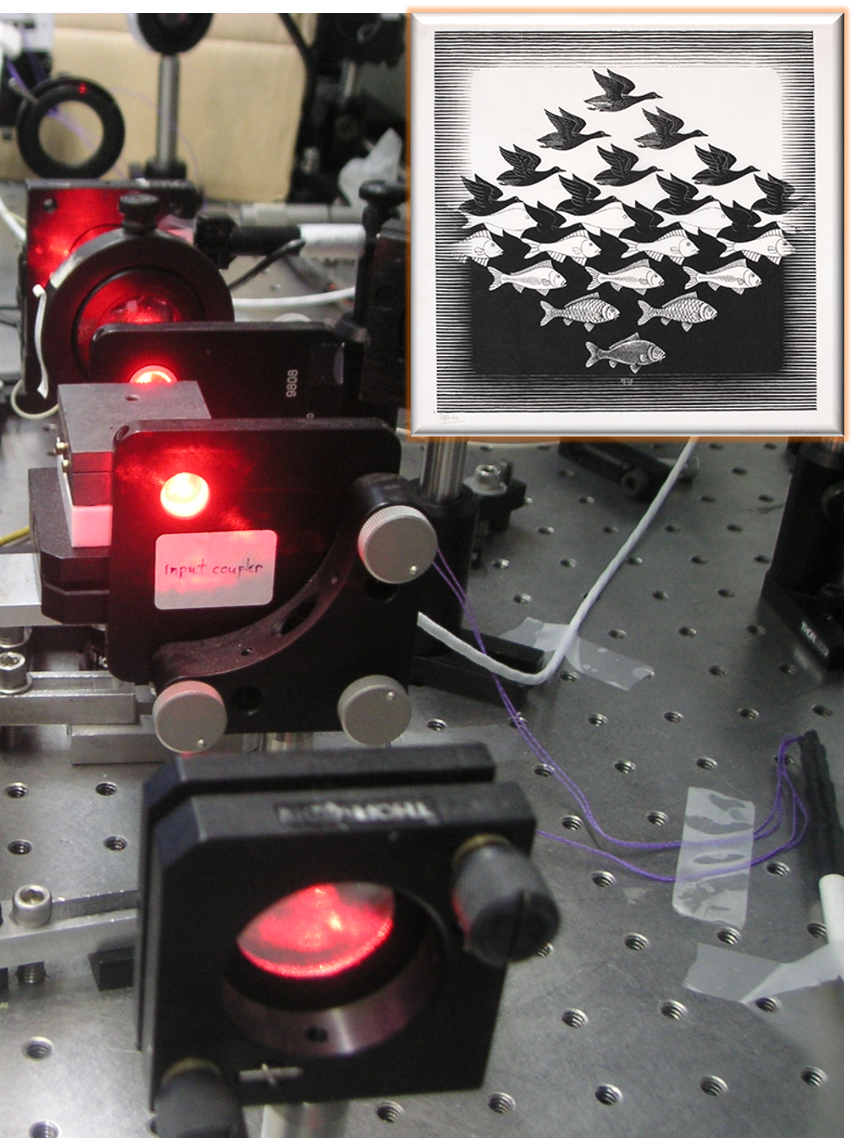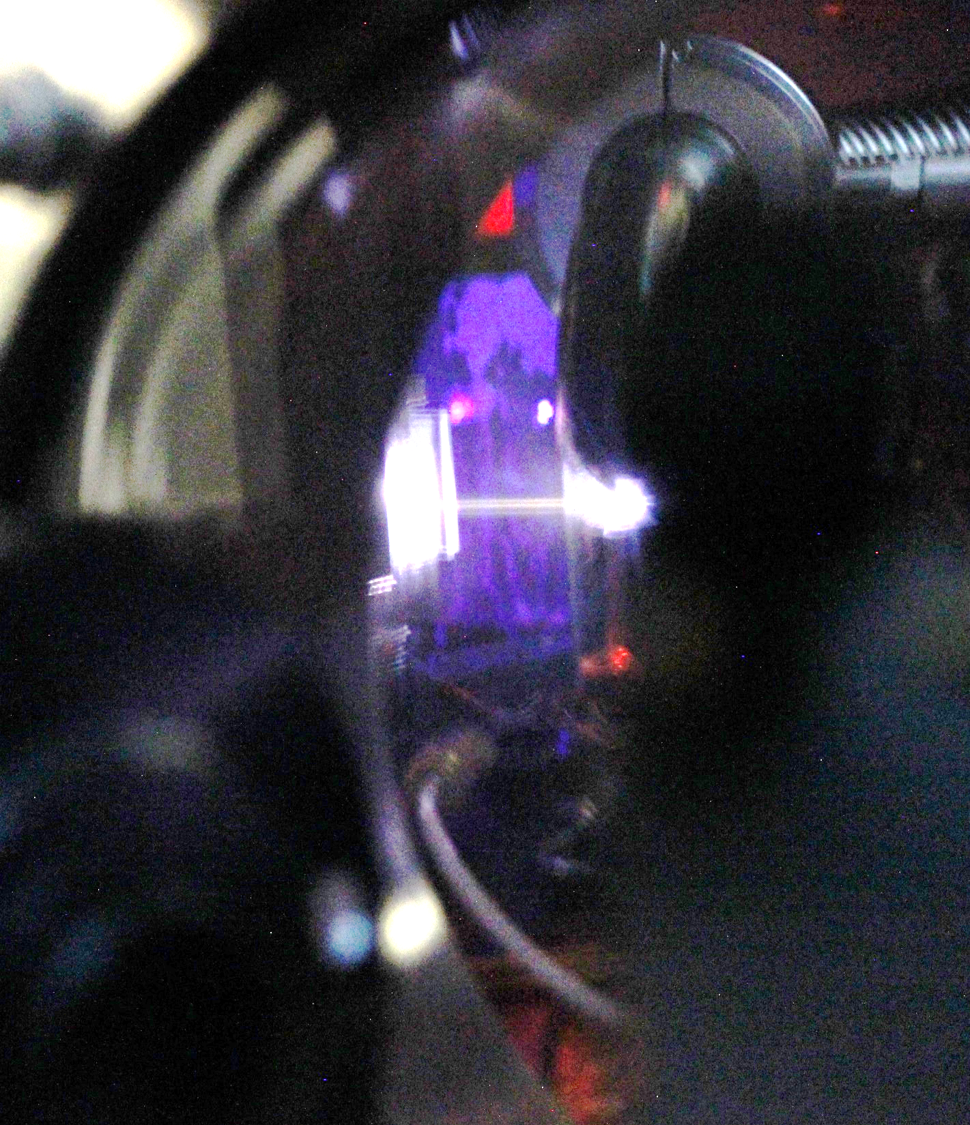
The research interests of the Laser Science Lab are broad and varied, including ultrafast and nonlinear optics, laser physics, laser stabililzation, metrology and optical magnetometry. A few specific research themes are detailed below.

Adiabatic nonlinear optics system that efficiently converts infrared (invisible) laser light to red laser light. The adiabatic process is gradual yet brings a strong change, in analogy with the gradual change from white fish to black bird seen in the top right image (M.C. Escher’s “Sky and Water I”).
Optical frequency comb lasers are a special type of stabilized lasers, producing a very well defined set of optical frequencies (colours) over a broad frequency range. These lasers have many applications, including atomic clocks and spectroscopy for basic science research, telecommunication, and environmental sensing. However, conventional frequency comb devices are very sensitive to vibration, temperature and other environmental influence. This sensitivity limits their application outside of a well-controlled laboratory environment. We research novel approaches for creating robust frequency combs that can bring the strengths of these lasers into real-world applications, as well as make them more accessible to non-laser-expert researchers in the natural sciences and engineering. Our schemes are based on adiabatic nonlinear optics, which is a novel approach for highly-efficient manipulation of light, co-pioneered by Prof Porat. This approach is based on using slow spatial variation along a medium that interacts with laser light, rather than a medium with fixed or periodically-alternating properties. Adiabatic nonlinear optics defeats long-standing trade-offs between efficiency and robustness.

High-power infrared laser interaction with matter. The process is accompanied by plasma generation due to the high laser intensity. The plasma is responsible for the white-violet glow.
Generating high-power stabilized ultraviolet lasers by direct laser action is extremely difficult due to material properties. Stable ultraviolet laser capabilities remain limited as compared to infrared and visible lasers. For this reason, spectroscopic applications in the ultraviolet have also been limited. These include nuclear clocks, tests of quantum electrodynamics, studies of basic atomic and molecular physics, material research, and precision magnetometry (see below). An alternative to direct ultraviolet lasing is the generation of ultraviolet light via nonlinear light-matter interaction, which can be achieved with sufficiently powerful infrared lasers. We develop high-power infrared frequency combs that can directly generate high-power ultraviolet frequency combs. We also experimentally study and develop ultraviolet generation schemes, including the use of adiabatic nonlinear optics. Interestingly, these ultraviolet light sources could be powerful enough to rival large-scale facility sources of high-power ultraviolet light (e.g., synchrotron), thus bringing facility-scale capabilities to the tabletop.

Artist's conception of the interaction between frequency comb pulses and atomic gas. Image credit: Jun Ye and Steven Burrows/JILA.
Atomic magnetometers measure magnetic fields by detecting the effect of these fields on spin-polarized atoms (i.e., atoms with aligned electronic or nuclear spin). Applications of atomic magnetometers include tests of fundamental physics, nuclear magnetic resonance spectroscopy (for chemical analysis), and magnetic resonance imaging (MRI, e.g., for medical diagnosis or the study of porous materials). State of the art atomic magnetometers are limited by a trade-off between the detection method’s robustness against noise and external interferences (background) and spin relaxation time (the time it takes the spins to become misaligned). Optical spectroscopic detection is most resilient against noise and background, however it is limited to atomic species with relaxation times well below 1 minute. Optically inaccessible noble gas nuclear spins offer relaxation times reaching hundreds of hours. These could be accessed optically with the high-power stabilized ultraviolet lasers that we are developing. These lasers could therefore open the way to magnetometric sensitivity that is orders of magnitude better than today’s state of the art capabilities. In the long term, we will apply these novel magnetometers to push the boundaries of tests of fundamental phyiscs, including searches for axionic dark matter and test of local Lorentz invariance (which underlies both the Theory of Relativity and the Standard Model). The ultraviolet lasers will interact with noble gases very efficiently, so they can be used to detect extremely small quantities of noble gases extracted from environmental samples. The lasers' stability will make it possible to resolve the relative quantities of different isotopes of the same noble gas (called isotope ratios). Noble gas isotopes are naturally occuring and chemically and biologically inert, so their ratios are only affected by physical environemntal processes. They are highly valuable to geoscientists, as they hold a record of climate history, groundwater age and recharge rates, atmospheric composition, and many other environmental factors and processes. Currently, enviromental noble gas isotope ratios are mainly determined via mass spectrometry, and in a few cases with atom trap trace analysis. Both methods are time and resource intenstive and have sigifnicant limitations. We expect our laser-based method to have a much higher throughput and even better perfomance, while being realized with a simple tabletop apparatus.